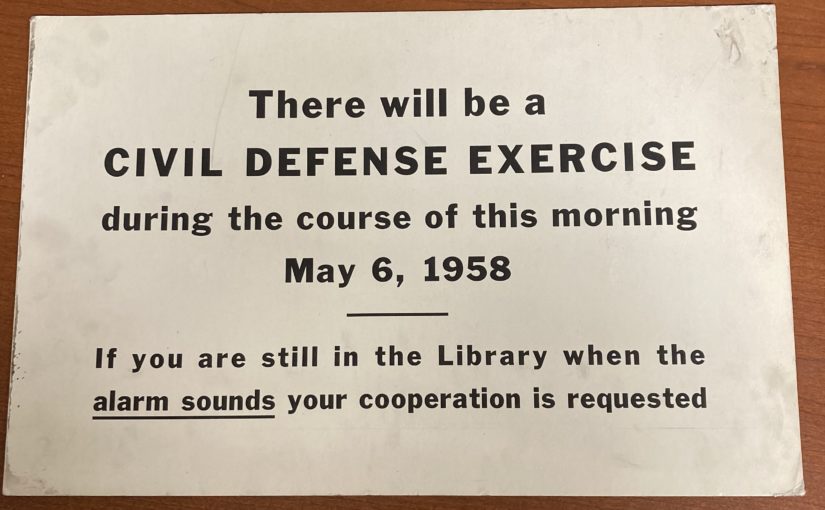Operation Alert was a Cold War exercise designed to assess how prepared both government agencies and citizens were in the event of a nuclear attack on the United States. Starting in 1954, about 200 cities around the country took part in these drills until the project ceased in 1962. Worcester, Massachusetts, the home of the American Antiquarian Society, was one of these cities.
This fall I’ve been an intern at AAS as part of my graduate program in public history and archives, and one of my projects has been cataloguing the objects in the Society’s archives. While working with these objects, I came across a sign that reads, “There will be a civil defense exercise during the course of this morning May 6, 1958. If you are still in the Library when the alarm sounds your cooperation is requested.” On that day, alarms and air raid sirens would have gone off and people were required to stay indoors, sheltering in place for fifteen minutes. Depending on the location, certain penalties were in place for noncompliance. For example, in New York City, there was a fine of $500 for people who didn’t follow the directions of the Civil Defense Agency.
This agency had a clear situation in mind when they devised drills and exercises. Not only did they plan the drill itself, but they created an entire fictional story around what might cause a scenario where the United States was under attack. In this case, the story goes that tensions around the world increased to the point where, during the week prior to May 6, 1958, things came to a head. On May 6, with only a couple hours’ warning, an “attack” was launched on the country. This drill scenario evaluated government and citizens’ reactions to a potential event when little time was available to develop a strategic plan to protect themselves and their constituents as best they could. The 1958 test was taken extremely seriously, with members of multiple organizations coming up with reasonable facsimiles of a nuclear attack plan that was as realistic as possible.
The exercise was also meant to test preparedness in general. At the time of “attack,” was there enough food and clothing in a city’s holdings to supply people who were sheltered? What about medical supplies? Was there a plan for transporting people to places where they would be safe? Was there a power supply and fuel that could be depended upon? As part of the drills, communications would black out on the day following the “attack” in order to replicate what might really happen and gauge the responses of the local and federal agencies. The plans were very detailed, even down to using the actual weather conditions of the day to model potential nuclear fallout.
Not everyone cooperated with the sign requests like the one at AAS, however. A great many Americans protested, some because they felt the drills were terror-inducing and not actually effective, and others because they were pacifists. Many protesters said it was laughable that the government thought they could protect people during a nuclear attack and proposed putting the money and resources that went into these drills toward attaining peace. Peace was, they claimed, the only defense against nuclear war.
The final Operation Alert exercise occurred in 1961, when over two thousand people protested in New York City, and even more at college campuses and other locations nationwide. The project itself was canceled in 1962. You can read the full standards for the 1958 Operation Alert exercise issued by the Office of Defense Mobilization and the Federal Civil Defense Administration here.

